Unidentified egg masses
This is a page for messages about unidentified eggs and general comments.
Related messages
Huge egg mass - Doris montereyensis ?
August 14, 2007
From: Jackie Hildering
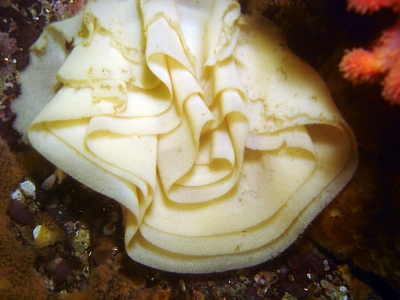
Hello Bill and David,
In full understanding that you prefer not to deal with photos of egg masses alone - please feel free to disregard this submission.
I so send it because I was just blown away by the sheer size of it. It was at least 22 cm in diameter (having used my light to estimate size). In my floundering about to match egg masses to nudibranchs in our area I do feel more secure of the bigger species and do believe this to be the mass of Doris montereyensis. Just want to contribute as it may be of some value to know how big these masses might get.
Locality: Browning Wall, 43', British Columbia, Canada, Pacific Ocean, 06 August 2007, w. Photographer: Jackie Hildering.
Best wishes,
Jackie
earthlingenterprises@telus.net
Hildering, J., 2007 (Aug 14) Huge egg mass - Doris montereyensis ?. [Message in] Sea Slug Forum. Australian Museum, Sydney. Available from http://www.seaslugforum.net/find/20420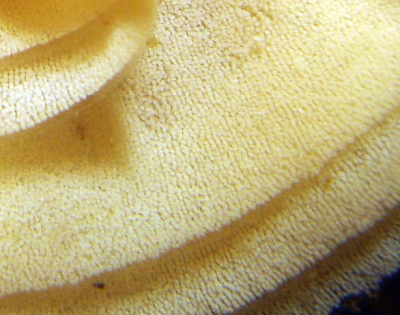
Hi Jackie,
Ouch. There is no question that this looks like the egg mass of a dorid, but you have several species of Doris in your area capable of laying a mass this size. You are likely correct, and we note the huge size. It is notably large, but sorry, can't render an ID.
Dave Behrens
Behrens, D.W., 2007 (Aug 14). Comment on Huge egg mass - Doris montereyensis ? by Jackie Hildering. [Message in] Sea Slug Forum. Australian Museum, Sydney. Available from http://www.seaslugforum.net/find/20420Pleurobranchus forskalii eggs?
May 3, 2005
From: Brian James
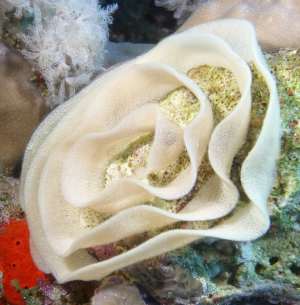
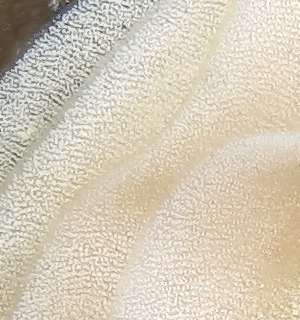
A night dive at Abu Nuhas, Red Sea, revealed these wonderful eggs. At first sight I thought Spanish Dancer but, of course, the eggs are the wrong colour. The egg mass was approximately 18cm x 11cm in size and was in 18M of water.
Locality: Abu Nuhas, Egypt. Red Sea. Depth: 18 m. Length: 18cm (approx.)
19th April, 2005. Coral Reef. Photographer: Brian James
Can you confirm that they belong to Pleurobranchus forskalii.
Many thanks
Brian James
jamesb@uk.ibm.com
James, B.M., 2005 (May 3) Pleurobranchus forskalii eggs?. [Message in] Sea Slug Forum. Australian Museum, Sydney. Available from http://www.seaslugforum.net/find/13686Dear Brian,
Although I guessed that the eggs in message #2217 could possibly be those of P. forskalii, it's a bit dangerous to extend that to all large white egg ribbons. For one, this ribbon doesn't have the sinuous folds, and secondly, we just don't know enough about these animals to be sure. If I say they 'probably are', in a little time the word will spread that all large white egg ribbons are Pleurobranchus forskalii, and we will forget that we don't really know. With luck, someone, one day, will find something laying an egg ribbon like this - and have a camera ready to record the occasion - Let's hope they send it to the Forum.
Best wishes,
Bill Rudman
Pink tiny nudibranch and concentric rings
March 25, 2005
From: Francesca Riolo
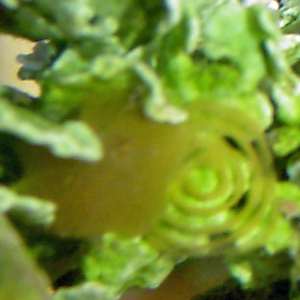
Hi,
I live in American Samoa and I just started a small aquarium to give a closer and longer look to the creatures I usually observe underwater. Three days ago I collected the first habitants including a tiny all pink nudibranch (4-5 mm).
Locality: Sliding Rock Beach, American Samoa. Depth: 0.4 meters. Length: 5 mm. 22 March 2005. Reef flat. Photographer: Francesca Riolo.
I am not an expert and I am not sure it is a nudibranch rather than something else (opisthobranch or some other invertabrate I am not aware of) though I am quite sure I can see the two front rhinophores and on the back the gills as I see on many nudibranch pictures (not visible on the attached picture). Are these ID keys that tells me is a nudibranch? The following day at night I noticed that he started producing some concentric pink rings beside its body...are these eggs? By the way I found it on the bottom part of a rock but already during transportation he choosed a piece of Halimeda (I think!) algae as its new home and never left it since then...
Today the rings are gone (maybe damaged by hermit crabs)...but I took a picture last night...i hope I have not been too long...I would like to know if possible what species this creature is and what those rings are and if they are eggs if there is something that might have induce it to produce them the second day of its aquarium life!( stress, halimeda algae...) Thanks a lot for your help!
Francesca
frahome@yahoo.com
Dear Francesca,
From your description of the rhinophores and gills in the middle of the back, your animal is a dorid nudibranch but without further information I can't say anything more. The 'concentric rings' are (or were) not concentric rings but a continuous spiral - and as you thought they were eggs. Dorid don't feed on algae so it was using the Halimeda as a place to hide, or wait for better times. Nudibranchs do often lay eggs when stressed but I can't say if this laying was a 'normal' activity or a stress-related event. Certainly other animals will eat egg ribbons.
Good luck with your aquarium and observations
Best wishes,
Bill Rudman
Galapagos egg ribbon
January 2, 2005
From: Julianne Parolisi
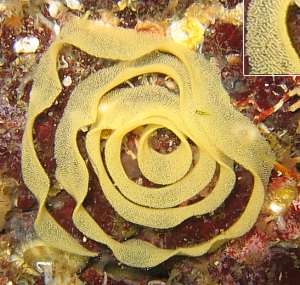
Hello again bill!
This question is regarding what i now believe is a nudibranch egg ribbon i found on a dive around Fernandina Island in the Galapagos. in browsing the forum i found a number of photos of egg ribbons, but none that matched exactly, and i am wondering if you or anyone might know which species it belongs to. i didn't notice any nudibranchs in the immediate area, but at a nearby site that same day i found millions of Tambja mullineri, the common (endemic, i think?) Galapagos species. as you can tell, the ribbon was not flattened but sticking straight out, and the diameter was about 2 inches.
Locality: Fernandina Island, Galapagos, Ecuador, Pacific Ocean. Depth: ~ 8 meters, Length: 2 inches, 15 November 2004. Photographer: Julianne Parolisi
Thank you, and thanks again for this amazing site! i have recently decided that i want to somehow get involved in nudibranch research, and this is a fantastic resource.
happy holidays,
Julianne
aurorable@gmail.com
Parolisi, J., 2005 (Jan 2) Galapagos egg ribbon. [Message in] Sea Slug Forum. Australian Museum, Sydney. Available from http://www.seaslugforum.net/find/12833Dear Julianne,
This is a nudibranch egg ribbon, you can see the individual eggs in the inset I have added to your photo. It is most probably a dorid egg ribbon but from your measurements seems a bit large for Tambja mullineri. However, in most cases, its very difficult to identify nudibranch egg ribbons to species. To be sure you really have to catch them in the act. However when you become familiar with a local population you can begin to make intelligent guesses. That's why I am always asking for photos of animals laying eggs.
Best wishes,
Bill Rudman
Nudibranch eggs on a fish
August 4, 2004
From: Chris Grossman
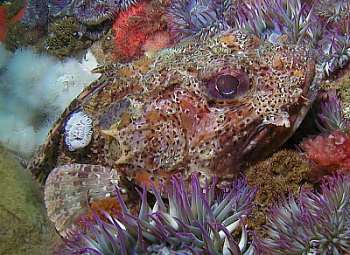
Bill,
On Friday July 16, 2004 I was diving at Begg Rock a pinnacle 10 miles Northwest of San Nicolas Island, California. On the third dive I encountered a California Scorpionfish (Scorpaena guttata) with nudibranch eggs on it's side. I have never observed that before. I don't know what type of nudibranch left the eggs, but I thought it was interesting since I have only seen eggs attached to hard substrates or plants in the past.
Alan Grant comments:
'My guess is that it is Hermissenda, but wait until the experts weigh in with their opinions. Since the Scorpion fish waits in ambush to feed and is relatively sedentary, it's not surprising that a nudibranch might crawl up on it's body, start laying eggs, and then go along for the ride when the fish moves'.
Chris Grossman
chris@diver.net
Grossman, C., 2004 (Aug 4) Nudibranch eggs on a fish. [Message in] Sea Slug Forum. Australian Museum, Sydney. Available from http://www.seaslugforum.net/find/12726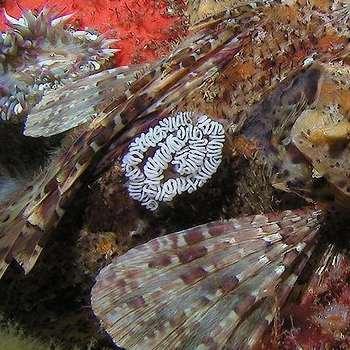
Thanks Chris,
The eggs could easily be those of Hermissenda. As Alan Grant notes, nudibranchs are certainly found crawling over fish, such as scorpaenids, which sit in one spot for considerable periods. I must say I have never seen one with an egg ribbon attached.
Best wishes
Bill Rudman
Unknown egg mass from Turkey
October 8, 2002
From: Erwin Köhler
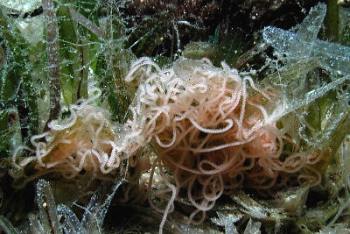
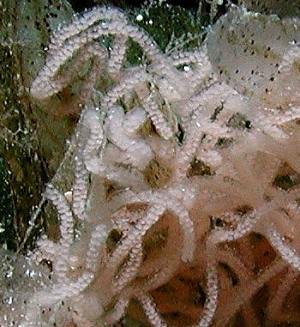
Dear Bill,
attached are 2 shots of an unknown egg-mass from my recent trip to Kas, Turkey. I'd like to say they are from a seahare, but they look similar to the eggs-masses of Bulla ampulla from the Philippines. I found dozens of these egg-masses, but no seahare nor something else larger enough.
data:
size approx. 12 cm
depth 10-15 m,
date 19 Sept. 2002
divesite "Oasis"
Erwin
Erwin@medslugs.de
Köhler, E. , 2002 (Oct 8) Unknown egg mass from Turkey. [Message in] Sea Slug Forum. Australian Museum, Sydney. Available from http://www.seaslugforum.net/find/8121Dear Erwin,
Certainly looks like a sea hare or some cephalaspidean. The eggs seem much larger than those in your photos of Bulla ampulla from the Philippines. Perhaps Baki Yokes will recognise it
Best wishes,
Bill Rudman
Nudibranch Egg masses
July 19, 2002
From: Laurette Hanekom
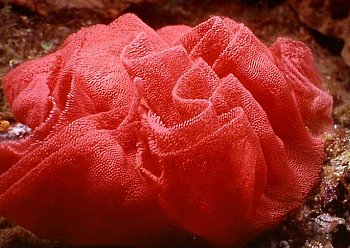
Dear Dr. Rudman
I am interested in the egg deposits of nudibranchs and have three questions.
1. What determines the colour of the egg mass? Is it influenced by what they eat?
2. How long does it take before the eggs hatch?
3. What happens to the nudibranchs once they hatch? Do they just float along with the current or do they live and feed around the place that the egg mass was deposited?
I have attached 3 slides of nudibranch egg masses which vary in texture and colour. On slide 1 the eggs are encased in a jelly-like substance and the eggs differ in texture from other egg masses found. The eggs are very close together and can not be distinguished with the naked eye. Is this perhaps a recently deposited mass? Do the eggs grow in size and then loosen the texture of the egg mass? Slides 2 and 3 show eggs that are more easily distinguishable and also differ in colour from pink to red. Does the colour of the egg mass change as it matures?
A long question I know, but I would appreciate any information on this subject which has long held my interest.
Many thanks
Laurette Hanekom
South Africa
allscuba@lantic.net
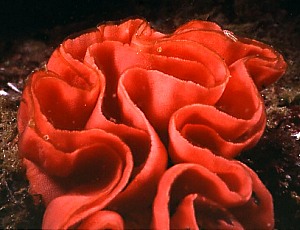
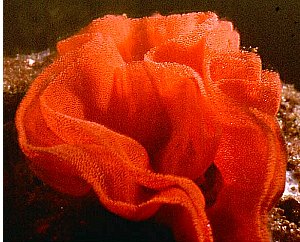
Dear Laurette,
The best way to find some information on eggs and development is to go to the GENERAL TOPICS INDEX and look at entries concerning 'eggs' and 'larvae'. If you look down through the messages on each page you will find a lot of information on each topic. Unfortunately at present I haven't had the time to prepare summary accounts on these inetersting topics. Another way to find things in the Forum is to use the SEARCH button.
Best wishes,
Bill Rudman
Eggs
July 18, 2002
From: Alice Lee
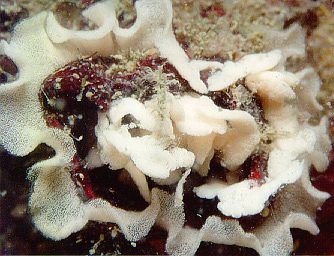
Hi Bill,
I came across some circle of white stuff which seems like nudibranch eggs to me, it covers an area of 4cm x 4cm but there is no sign of nudibranch around, can you identify which nudibranch it belongs to or if it is nudibranch eggs.
Thanks.
Alice
alee@dlink.com.sg
Lee, A., 2002 (Jul 18) Eggs. [Message in] Sea Slug Forum. Australian Museum, Sydney. Available from http://www.seaslugforum.net/find/7172Dear Alice,
Yes they certainly look like nudibranch eggs. It is probably a species of dorid, but we don't know enough about the eggs of individual species to be able identify egg masses, except in a few special cases,
Best wishes,
Bill Rudman
Platydoris formosa? - egg ribbon
June 27, 2002
From: Todd Garthwaite
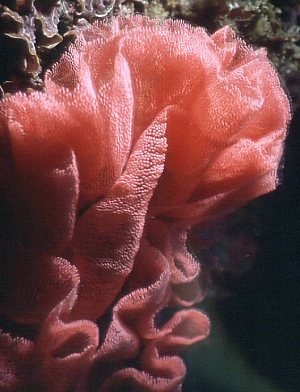
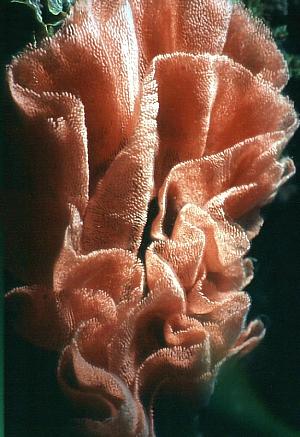
Hi Bill.
I came across a very large egg ribbon, that I thought might be from a Platydoris formosa, (Neville Coleman has a similar picture of a nudibranch egg mass on pg. 60 of his book 1001 Nudibranchs). With its distinct reddish color, I also thought it might be from a Hexabranchus sanguineus. I've never seen an egg mass like this one before.
Any ideas?
Site: "Jin-Sha Wan" (["Golden Sand Bay"], N.E. Coast, Taipei County, Taiwan)
Date: 08 June 2002
Time: 09:43am
Depth: 7 meters
Temp: 25 degrees C.
Size: Approx. 150 + mm (semi-coiled)
Stay golden.
Best wishes always, (and many thanks),
Todd Garthwaite
(Taipei, Taiwan)
typhoontoddy@yahoo.com
Garthwaite, T., 2002 (Jun 27) Platydoris formosa? - egg ribbon. [Message in] Sea Slug Forum. Australian Museum, Sydney. Available from http://www.seaslugforum.net/find/7247Dear Todd,
We know so little about egg masses that it is always difficult to identify them except in very special circumstances. This looks quite like the egg ribbon of Hexabranchus but we have to be careful we don't start making up myths. Unless we actually see an animal laying an egg ribbon, it is almost impossible to safely identify it unless it has a very unique shape and is on the special food of a particular nudibranch. For example I am fairly confident in identifying some species of Rostanga but for the vast majority of nudibranchs it is a very risky business.
Best wishes,
Bill Rudman
Do Sea Slugs lay eggs?
March 13, 2002
From: Emily
I would like to know if sea slugs lay eggs
Emily
grade2c@sfxboxh.catholic.melb.edu.au
Emily, 2002 (Mar 13) Do Sea Slugs lay eggs?. [Message in] Sea Slug Forum. Australian Museum, Sydney. Available from http://www.seaslugforum.net/find/6416Dear Emily,
The short answer is yes, sea slugs do lay eggs. They usually lay them in a long string, like a string of beads, which is coiled up in a jelly mass to protect the eggs from predators and bacteria. Many species have very elaborate egg ribbons, and often you can identify the slug that laid the egg ribbon just from its shape.
There is a lot of information and photos of eggs on the Forum in the Fact Sheets, and the many messages. The best way to find it is go to the SEARCH PAGE and type in egg. You will get a list of over 400 photos and messages to have a look at. If you are interested in other general information click on the GENERAL TOPICS Button at the top of the page and you will get an index of topics which may be of interest.
Best wishes,
Bill Rudman
A strange place to lay eggs
January 25, 2002
From: Mary Jane Adams
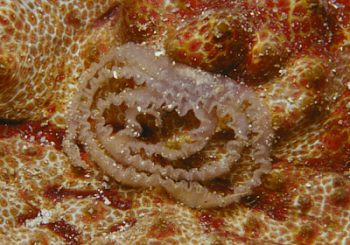
Hi Bill,
When I was in the Solomon Islands last November a fellow diver told me about a pearlfish he had just seen sticking out of a sea cucumber. I was interested in photographing the pearlfish, so I went seaching in the area he described. I never found the cucumber hosting the pearlfish, but I did find one carrying nudibranch eggs. The egg ribbon was neatly coiled in the middle of the cucumber's back.
Interestingly, it was just a few meters away from another bizarre nudibranch find, the two Gymnodoris nigricolor on the shrimp goby.
Depth: about 15 meters,
Divesite: Wickum Island, New Georgia Group, Solomon Islands
Best regards,
Mary Jane
divepng@yahoo.com
Adams, MJ. , 2002 (Jan 25) A strange place to lay eggs. [Message in] Sea Slug Forum. Australian Museum, Sydney. Available from http://www.seaslugforum.net/find/6077Thanks Mary Jane,
Certainly strange place to lay eggs, but I guess as long as the holothurian didn't start burrowing, they would be safe for a while.
Best wishes,
Bill Rudman
Baki's Egg coils
November 6, 2001
From: Bernard Picton
Hi Bill,
I think the top picture in Baki's spawn message is probably Haminoea (?navicula). The eggs in rows like this and shape of the coil are exactly the way I've seen the eggs of this species, it normally climbs up away from it's muddy substratum to lay the spawn on a prominent plant or animal.
The lower right spawn could be of almost any large Dorid, Geitodoris planata lays eggs with this sort of wavy top edge and so does Atagema gibba. In the Mediterranean there are a lot of other candidates.
In a separate message I've sent unpublished in situ photos of Atagema gibba and its spawn coil.
Bernard
bernard.picton.um@nics.gov.uk
Picton, B.E., 2001 (Nov 6) Baki's Egg coils . [Message in] Sea Slug Forum. Australian Museum, Sydney. Available from http://www.seaslugforum.net/find/5629Thanks Bernard,
Interesting to hear that the European Haminoea has such a 'flattened' egg coil. The common New Zealand species, Haminoea zelandiae, with which I am most familiar, has a soft jelly-like, sausage shaped egg mass containing a spiral string of bright yellow eggs.
Bill Rudman
Whose eggs are these?
November 2, 2001
From: Baki Yokes
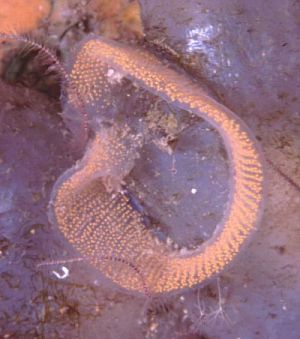
Dear Bill,
I have some egg ribbon photos, but I don't know which species they belong to. The eggs that are seen in the first photo, are always found on this tunicate species, but nowhere else. Could it be possible that these tunicates are potential food for these slugs? And whose eggs are they? I will also be pleased if it is possible to identify the other egg ribbons.
• UPPER RIGHT: Istanbul, Turkey. Divesite: Yassiada. Depth: 26m. Ribbon size: approx. 3.5 cm in diameter. 7 October 2001
Photo: Baki Yokes
• LOWER RIGHT: Istanbul, Turkey. Divesite: Yassiada, Depth: 20m, Ribbon size: approx. 5 cm in diameter. 7 October 2001
Photo: Baki Yokes
• LOWER LEFT: Antalya, Turkey. Divesite: Uç Adalar. Depth: 25m, Ribbon size: approx. 15 cm in diameter. June 2001
Photo: Hasan Yokes: hyokes@turk.net
Best wishes
Baki
bakiyokes@turk.net
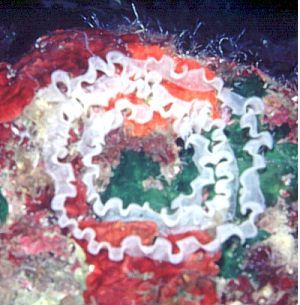
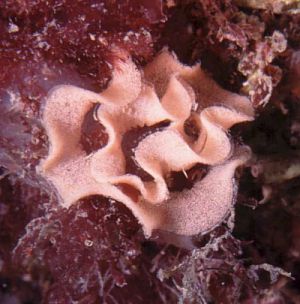
Dear Baki,
It is very difficult to identify egg masses with any certainty except in certain special cases, when an egg mass has very special characters, and we know the fauna of the area in which t was found very well. Unfortunately the fauna of your region is obviously very poorly known so the chance of identifying egg masses is pretty slight. It is possible that the egg mass which is always found on tunicates belongs to a species of Goniodoris, which feed on tunicates, but in my experience they usually lay their eggs in cavities they have eaten out of the tunicate colony. The lower left one could also be from a species of Dendrodoris. But really anything I say is just a guess.
Perhaps someone will recognise them, but I wouldn't be too optimistic.
Cheers,
Bill Rudman
Are these eggs?
October 23, 2001
From: Beniamino Usai
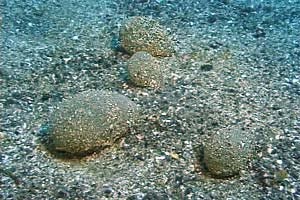
Dear Dr Rudman
Do you know what the strange objects are that you can see on the sand in the attached photo by Guido Picchetti? The photo was taken in the south of Italy in shallow water. Those bubbles of mucus are large 3-7 centimeters and they are fixed to the sand by a strong filament. They are usually covered with sand grains. They are perhaps eggs of gasteropods?
Thank you
Best regards
Beniamino Usai
marinelife@iol.it
Usai, B., 2001 (Oct 23) Are these eggs?. [Message in] Sea Slug Forum. Australian Museum, Sydney. Available from http://www.seaslugforum.net/find/5508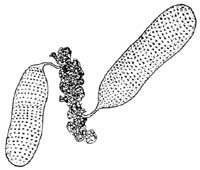
Dear Beniamino,
There are two possibilities. One they are the egg mass of a polychaete worm, or they are the egg mass of an opisthobranch bubble shell of the family Aglajiidae or Philinidae. The drawing on the right is of the egg masses of the philinid Philine auriformis from New Zealand [approx 20mm long]. Aglajid egg masses are usually more spherical, as in your photo. An example of an aglajid with an egg mass like in your photo would be the Indo-West Pacific species Philinopsis cyanea.
If it is a worm egg mass then the microscopic eggs will be scattered throughout the jelly. If they are the eggs of a bubble shell, then each egg will be enclosed in a thin capsule and all the capsules will be connected together by a short filament to form a string of eggs which are arranged in a spiral within the egg mass. If they grow to 7cm in length, they may be a bit large for an opisthobranch, so perhaps they are a worm egg mass.
Best wishes,
Bill Rudman
number of eggs
October 7, 2001
From: Jeanette McInnes
Dear Dr. Rudman,
Firstly, I love your site & read it as often as time permits.
22 - 29 Sept. I went to Osprey Reef [North Queensland, Australia]on board Nimrod, & did the nudibranch segment of the evening marine bio. talk. A guest asked me, "How many eggs do nudibranchs lay at a time?" for which I had no answer. Could you please answer this, so I'm not caught out again?
While on the trip I saw a nudibranch which doesn't figure in the Debelius nudibranch book. He had a jet black mantle with pinprick sized neon red specks and mauve rhinophores and (hexabranchial) gills. About 10m deep, water temp 27 degrees. Do you know which nudibrach he might be? Sorry, I only have a MX-5, which doesn't have macro capability, so I don't have a photo to show you. of average build (like a Chromodoris lochi in bulk) and about 4cm long. He was found doing his thing at Ribbon Reef #10, Great Barrier Reef.
Thank you in advance for your input.
Jeanette McInnes
Cairns, Qld.
jlmc01@ozemail.com.au
McInnes, J., 2001 (Oct 7) number of eggs. [Message in] Sea Slug Forum. Australian Museum, Sydney. Available from http://www.seaslugforum.net/find/5400Dear Jeanette,
I sometimes surprise myself with how well the SEARCH facility works on the Forum. I thought someone had asked this question before so I typed in 'how many eggs' and found Mike's earlier message. Have a look at that. Basically it depends on which species you are asking about.
Concerning your mystery black nudibranch, I am not sure. I guess it could have been a colour form of Dendrodoris nigra, but without a drawing or a photo I can't be sure.
Best wishes,
Bill Rudman
Opisthobranch egg masses
October 7, 2000
From: Phanor Montoya
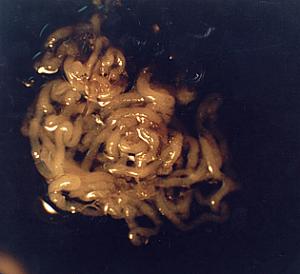
Dear Bill:
Could you identify these egg masses? They were are all found on the brown alga Dictyota dichotoma.
Phanor.
phamont@eudoramail.com
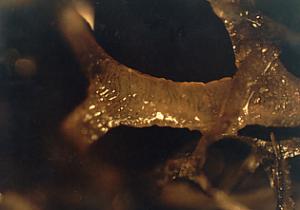
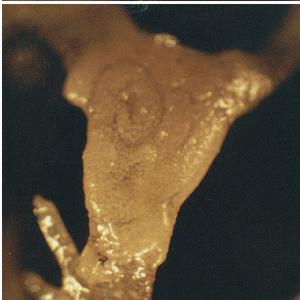
Dear Phanor,
Although in rare cases, such as in the dorid genus Rostanga, it is possible to identify egg masses to individual species, in most cases its is difficult to be sure.
Of your three egg masses:
• UPPER RIGHT: I am pretty sure this is a Sea Hare egg mass, probably a species of Aplysia or possibly Bursatella leachii.
• LOWER LEFT: This is hard to see but seems to be a fine string wrapped around the alga. I suspect it is an aeolid egg string.
• LOWER RIGHT: Could be an elysiid sacoglossan or a species of Nudibanch dorid.
As I said I can't give much more than a guess. That's why I am always asking for photos of animals laying eggs. It is the only way we will ever build up enough information to make identifying eggs to a species level, a real possibility.
Best wishes,
Bill Rudman.
How many eggs do sea slugs lay?
October 4, 2000
From: MIKE
HI. I NEED TO KNOW HOW MANY EGGS SEA SLUGS LAY AT A TIME.
MIKE
MIKE5422
MIKE, 2000 (Oct 4) How many eggs do sea slugs lay?. [Message in] Sea Slug Forum. Australian Museum, Sydney. Available from http://www.seaslugforum.net/find/3086Dear Mike,
There is no simple answer to your question. In some species such as Vayssierea felis there can be as few as one or two eggs in an egg mass, while at the other extreme the Sea Hare Aplysia fasciata is estimated to lay as many as 25 million eggs(Thompson & Bebbington, 1969). The North American species Aplysia californica is estimated to lay 1.5 million eggs (Kandel, 1979).
If you have a look at the list of General Topics you will a number of them are to do with eggs. Have a look at them for a general background idea on the range of egg ribbons Sea Slugs produce and why there is such a difference in egg numbers. You could also use the Search Button and type in egg. That will give you a much larger list of pages to look at with pictures of Sea Slug eggs.
Basically there are three main strategies used by sea slugs. They can have very many very small eggs which hatch into free-swimming veliger larvae that spend some time in the plankton feeding before settling down. This is a dangerous life for the larvae, but because there are so many some usually survive. At the other extreme are slugs which have only a few large eggs which hatch out, not as free-swimming larvae, but as tiny crawling slugs. This relatively 'safe' way of producing off-spring is relatively expensive in energy so only a few eggs are able to be produced.
There is a sort of 'intermediate 'third method' where some species produce a reasonable number of quite large eggs. These eggs turn into free-swimming larvae which don't feed and only spend a little time in the plankton.
The number of eggs produced depends on many factors, including the size of the animal, how well-fed it is, and the type of larval development it has.
Best wishes,
Bill Rudman.
PS: Your email address is incomplete so I can't let you know I have posted this answer.
Rudman, W.B., 2000 (Oct 4). Comment on How many eggs do sea slugs lay? by MIKE. [Message in] Sea Slug Forum. Australian Museum, Sydney. Available from http://www.seaslugforum.net/find/3086Eggs to identify
February 21, 2000
From: Valda Fraser
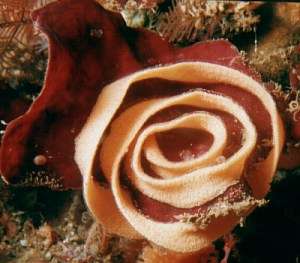
Dear Bill
I noticed these eggs and decided to take a photo. Hopefully you'll know which kind of nudibranch laid them. How long does it take them to hatch?
Locality: South Coast KwaZulu-Natal SOUTH AFRICA, Scottburgh - 25m. 23 Jan 2000.
Regards
Valda Fraser
iti04937@mweb.co.za
Dear Valda,
I'm afraid it is very difficult to identify nudibranchs from their egg masses. Firstly we know the egg masses of very few species, and secondly, quite a few have an egg ribbon very similar to your photo except for the colour. Some species, like in the genus Rostanga, have egg masses which are so distinctive that they can be used to identify the species, but that is very rare.
So if you ever see an animal laying an egg ribbon it is well worthwhile photographing it and the slug.
Have a look in the Gneral Topics Index for some other information on eggs and use the Search button as well because I have chatted about egg shape, development times etc on a number of occasions.
Best wishes,
Bill Rudman.
